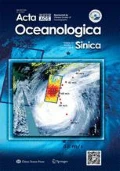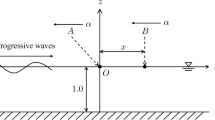Abstract
On the basis of the wave action balance equation which incorporates refraction, diffraction, reflection and wave-current interaction, a directional spectral wave transformation model WABED is developed for predicting the irregular wave refraction-diffraction with strongly reflecting structures in coastal regions. In the model, diffraction is taken into account by introducing a term formulated from a parabolic approximation wave equation, and reflection is calculated through a back-marching numerical approach at the reflecting boundary. Two experimental data sets are used to examine the performance of present model with regard to wave characteristics around reflecting coastal structures. One is from a physical experiment at idealized inlet with parallel jetties, while the other is from a laboratory study on a coastal project of the concave breakwater. Reasonably good agreements are found for both cases, revealing the applicability of the present model for predicting combined wave refraction-diffraction processes with strongly reflecting coastal structures.
Similar content being viewed by others
References
Booij N, Ris R C, Holthuijsen L H. 1999. A thirdgeneration wave model for coastal regions. 1. Model description and validation. Journal of Geophysical Research, 104(C4): 7649–7666
Chen Xiaowen, Zheng Jinhai, Zhang Chi. 2010. Evaluation of diffraction predictability in two phase averaged wave models. China Ocean Engineering, 24(2): 235–244
Holthuijsen L H, Herman A, Booij N. 2004. Phasedecoupled refraction-diffraction for spectral wave models. Coastal Engineering, 49(4): 291–305
Lin L, Demirbilek Z, Mase H, et al. 2008. CMS-Wave: A nearshore spectral wave processes model for coastal inlets and navigation projects. Coastal Inlets Research Program, Coastal and Hydraulics Laboratory Technical Report ERDC/CHL-TR-08-13. U.S. Army Engineer Research and Development Center, Vicksburg, Mississippi, USA
Madsen P A, Murray R, Sorensen O R. 1991. A new form of the Boussinesq equations with improved linear dispersion characteristics. Coastal Engineering, 15(4): 371–388
Mase H. 2001. Multi-directional random wave transformation model based on energy balance equation. Coastal Engineering Journal, 43(4): 317–337
Mase H, Oki K, Hedges T, et al. 2005. Extended energy balance equation wave model for multidirectional random wave transformation. Ocean Engineering, 32(8–9): 961–985
Peregrine D H. 1967. Long waves on a beach. Journal of Fluid Mechanics, 27(4): 815–827
Panchang V, Demirbilek Z. 1998. Wave prediction models for coastal engineering applications. Wave Phenomena and Offshore Topics, Chapter 4 in Developments in Offshore Engineering, Gulf Publishing Co, Houston, TX, 163–194
Rivero F J, Arcilla A S, Carci E. 1997. An analysis of diffraction in spectral wave models. Proceedings 3rd Intl. Symp. of Ocean Wave Measurement and Analysis, Waves’97, ASCE, 431–445
Smith J M, Resio D T, Zundel A. 1999. STWAVE: Steady-state spectral wave model, Report 1, user’s manual for STWAVE version 2.0. Instruction Report CHL-99-1, U S. Army Engineer Waterways Experiment Station, Vicksburg, MS
Smith J M. 2001. Breaking in a spectral wave model. Proceedings of the Fourth International Symposium of Ocean Wave Measurement and Analysis, Waves 01, ASCE, San Francisco, CA, USA, 1022–1031
Seabergh W C, Lin L, Demirbilek Z. 2005. Laboratory study of hydrodynamics near absorbing and fully reflecting jetties. Coastal Inlet Research Program, Technical Report ERDC/CHL-TR-05-8, U.S. Army Engineer Research and Development Center, Vicksburg, MS
Veeramony J, Svendsen I A. 2000. The flow in surf-zone waves. Coastal Engineering, 39(2–4): 93–122
Wei G, Kirby J T, Grilli S T, et al. 1995. A fully nonlinear Boussinesq model for surface waves. 1. Highly nonlinear unsteady waves. Journal of Fluid Mechanics, 294: 71–92
Zheng Jinhai, Tang Yu. 2009. Numberical simulation of spatial between wave breaking point and location of maximum wave-induced current. China Ocean Engineering, 23(1):59–71
Zheng Jinhai, Qian Jin, Zhong Husui, et al. 2006. Threedimensional physical study on wave characteristics in front of concave breakwaters. Proceedings of the second Chinese-German Joint Symposium on Coastal and Ocean Engineering, 100–106
Zheng Jinhai, Mase Hajime, Demirbilek Zeki, et al. 2008. Implementation and evaluation of alternative wave breaking formulas in a coastal spectral wave model. Ocean Engineering, 35(11–12): 1090–1101
Author information
Authors and Affiliations
Corresponding author
Additional information
Foundation item: The National Natural Science Foundation of China under Grant No.50979033, the Program for New Century Excellent Talents in University of China under Grand No. NCET-07-0255, the Specialized Research Fund for the Doctoral Program of Higher Education under Grant No.20100094110016 and the Special Research Funding of State Key Laboratory of Hydrology-Water Resources and Hydraulic Engineering Grant No.2009585812.
Rights and permissions
About this article
Cite this article
Zheng, J., Nguyen, V.T. & Zhang, C. Spectral wave transformation model for simulating refraction-diffraction with strongly reflecting coastal structures. Acta Oceanol. Sin. 30, 25–32 (2011). https://doi.org/10.1007/s13131-011-0102-y
Received:
Accepted:
Published:
Issue Date:
DOI: https://doi.org/10.1007/s13131-011-0102-y




